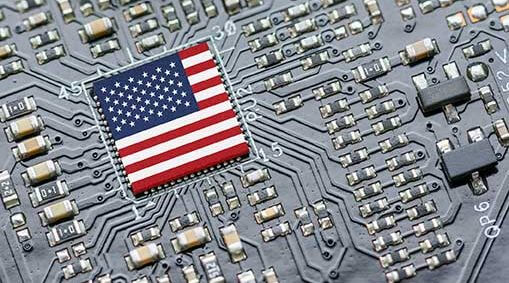Rainmaker 2023 panelists delve into expected benefits of the legislation, and ways for chip makers to score funding from it
Rollout of the 2022 CHIPS (“Creating Helpful Incentives to Produce Semiconductors”) and Science Act officially began in early 2023. The legislation is attempting to bolster the United States’ semiconductor industry in the wake of increasing dominance from Chinese, Korean, and Taiwanese competition. Focusing on funding and incentives for semiconductor research, design, and manufacturing within the United States, the CHIPS Act has industry participants and observers excited, believing that it could be a true game changer.
To help our semiconductor manufacturing customers, Model N organized a special panel at Rainmaker 2023 – its latest and most successful users’ conference, held in Nashville in June – to focus on the CHIPS and Science Act. On the panel were Fayrouz Saad, director of public engagement for the CHIPS program office at the U.S. Department of Commerce, and Kevin Thompson, vice president of sales operations at Qualcomm.
In this blog, I’ll put the CHIPS Act in context to explain why it’s such a big deal. I’ll then dive into benefits – for the country, and for individual semiconductor manufacturers. Finally, I’ll relay some tips the panelists had for winning funding from the program.
What the CHIPS Act is, and why it matters
According to Saad, three reasons drove passage of the CHIPS Act: economic security, national security, and future innovation. To achieve this, it allocated $52.7 billion total. Most ($39 billion) is tied to increasing manufacturing capacity; $11 billion is for semiconducting and advanced packaging research, and $2.7 billion is slated for defense.
“The pandemic showed us how important it is to bring chip production back to the United States and otherwise protect against further disruptions – from either manmade or natural disasters,” Saad told the Rainmaker audience.
Thompson agreed. “The actions that we take over the next number of years, will have ramifications for generations,” he said. “Semiconductors are key to the economy and to our lives. They are the new oil.”
Case in point: although semiconductors only account for 0.3% of U.S. economic output, they’re an important production input, representing 12% of our gross domestic product (GDP), adding up to $2.8 trillion, Thompson said. “At this point, pretty much anything you do requires a semiconductor at some point.”
The United States and European Union (EU) together saw their share of global chip manufacturing market share cut in half between 2001 and 2020 – from 19% to just 10%. Today, manufacturing is highly concentrated in China, Taiwan, and South Korea. This at a time when the market itself has tripled. “So, the US is losing share as the industry is growing,” said Thompson.
Much of this is due to the fact that other countries offered grants, tax credits, and other incentives to boost chip manufacturing. When looking at the economics, it costs 25 to 50% more to build and operate a fab in the United States as a direct result of this lack of investment.
“The CHIPS Act puts us back in the game,” Thompson told Rainmaker attendees.
Expected benefits from the CHIPS Act
The U.S. government hopes to reap major benefits in particular as a direct result of CHIPS with the overarching goal to have at least two semiconductor ecosystems in the U.S. by the end of the decade. Aiming to:
- Build 10 new semiconductor factories (fabs) in the United States
- Add 42,000 permanent direct semiconductor jobs and 280,000 indirect jobs to the economy
- Attract $210 billion additional investment from private sources
- Provide workforce training to support continued future growth of the U.S. semiconductor sector
But even as the United States tries to catch up, other countries are hustling. China announced it will spend $140 billion over the next decades on chip incentives. The EU has got $3 billion tapped to do the same. And South Korea, Taiwan, and Japan each have their own plans to promote the semiconductor industry in their own territories.
Opportunities for chip makers to seize
The first notice of funding opportunity was released at the end of February 2023. In it, the U.S. Department of Commerce announced that it is looking for applications for building fabs. “And as good taxpayer stewards, we’re doing our due diligence to ensure applicants that receive funds are adhering to their ends of the deal, that they’re meeting commitments and timelines,” said Saad.
Applicants will be judged on whether they’ve protected themselves against disruptions to the supply chain as well as cybersecurity threats so they can serve our national security interests. They also have to show the commercial viability of the products they propose to make in the form of market demand, and that they’re financially solid and will provide a healthy return on investment.
“We want to see a thorough market analysis, as well as evidence that they have the ability to bring in private investment,” said Saad. “That’s a recurring theme within the CHIPS program office that the government is only looking to make the minimum investment, and the applicants are able to take that and see reasonable growth.”
Local incentives provided by the states is another requirement all applicants must meet to help with construction, expansion, or modernization of fabs. And workforce development is an incredibly important piece to the program. “Applicants must show a workforce development plan, particularly for construction and manufacturing,” said Saad. Beyond that, there’s also a childcare requirement for any company requesting more than $150 million.” Environmental risks must be considered, as well as any permits or licensing that could potentially slow down progress on a project.
What to expect from the application process
Applicants for funding should anticipate a highly interactive and dynamic process to kick in once they submit their proposals, with substantial back and forth between them and the CHIPS program office. Applications are being accepted on a rolling basis.
“This isn’t your typical grant program,” said Saad. “It’s an iterative and holistic review process. We have a team of folks dedicated to working directly with applicants to get their application to the right place it needs to be in order to be successful.” So, there will be opportunities to improve applications as needed and as experts within the investments office see fit, she said.
Multiple projects can be proposed on the same application, and one company can submit multiple applications. The CHIPS program office will protect all proprietary and confidential business application.
In summary: The future is at stake
The CHIPS and Science Act is essential for supporting more science, technology, engineering, and math (STEM) capabilities in the United States.
But other governments aren’t standing still. The United States must continue to drive the industry forward. There’s a decided call to action to change the direction that chip manufacturing has been going in for the past two decades.
“We must keep younger generations coming into the industry,” said Thompson. “If we don’t train people in science and engineering, we won’t have the workforce and the work will go somewhere else.”
For more information about the CHIPS and Science Act, go to https://www.modeln.com/blog/us-semiconductor-revival-the-chips-and-science-act-of-2022/
















